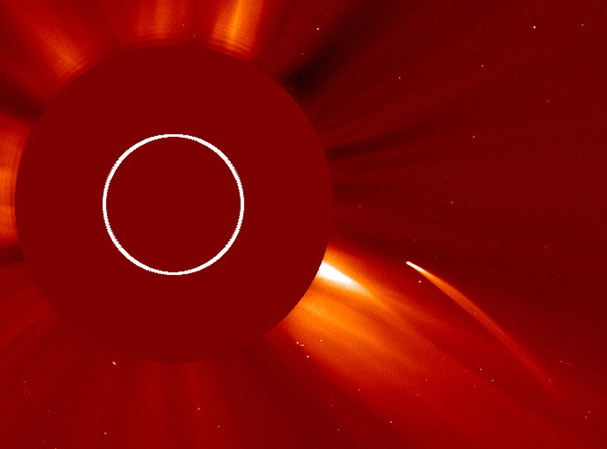Create a free profile to get unlimited access to exclusive videos, sweepstakes, and more!
The Sun fries a comet and we got to watch

In July of last year, I wrote about a comet that passed extremely close to the Sun. Astronomers have now had a chance to pore over that data, and were able to determine some very cool stuff.
First, here's the video of the comet's fiery demise (watch it in HD to make it easier to spot the comet):
See it? It's faint, but there. Actually, there are a lot of observations from multiple observatories and detectors, which allowed astronomers to find out quite a bit about this doomed chunk of ice and rock.
For one thing, it was screaming along at about 650 kilometers per second (400 miles/second) as it flamed out. To give you an idea of how flippin' fast that is, it would've crossed the entire United States in about eight seconds.
Yeah, I know.
It also passed an incredible 100,000 km (62,000 miles) above the Sun's surface. Have you ever stood outside on a hot day, and thought the Sun would cook you? Now imagine the Sun filling half the sky. That's what that comet saw. No wonder it disintegrated.
As it approached the Sun, it was watched by NASA's Solar Dynamics Observatory. In its final 20 minutes or so, the comet broke up into a dozen pieces ranging from 10 - 50 meters in size (and no doubt countless smaller ones too small to detect), with a tail of vaporized material streaming behind it that went for thousands of kilometers. For that size, it would've had a mass of hundreds of thousands of tons -- about what a loaded oil tanker weighs on Earth!
We've learned a lot about how comets break up and disintegrate by observing this event, but it's raised further questions: like, why did we see this at all? Comets are faint, and to be able to see it this way against the bright Sun is odd. It was definitely one of the brightest comets seen, but it's interesting to me that it appears to glow in the ultraviolet, as it did in the above video. That means, at that wavelength, it was brighter than the Sun! It wasn't like a meteor, burning up as it slammed through material, so some other process must have affected it. I suspect that the Sun's strong magnetic field may have had something to do with it; in the far ultraviolet magnetism is a strong player. Gas under the influence of intense magnetic fields can store a lot of energy, which is why sunspots -- themselves the product of magnetic squeezing -- look bright in UV.
Perhaps as the comet broke up, the particles inside got excited by the magnetic fields of the Sun and glowed. I'm no expert, and I'm spitballing here. The thing is, no one is exactly sure. But that doesn't mean we won't find out. Nothing makes a scientist's noggin itch as much as a mystery like this, something apparently misbehaving.
One of the single most important words in science is "yet". We don't know yet. But we will. Someone'll figure this out, and we'll have one more victory in our quest to better understand the Universe.
Science! I love this stuff.
Credits: Credit: NASA/SDO; SOHO (ESA & NASA)
Related posts:
- NASAâS SDO captures final moments of a comet streaking across the Sun
- Amazing video of comet on a solar death dive
- Ten Things You Donât Know About Comets
- The comet and the Coronal Mass Ejection



























